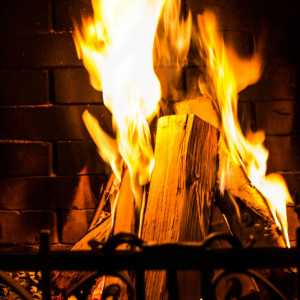You want to get the most out of your fireplace in terms of heat and efficiency, and you want to keep your home safe from the dangers of a chimney fire. The best way to do this is to burn only properly seasoned firewood in your fireplace or woodstove.
What is properly seasoned firewood?
Wood comprises a series of tubes that carry water from the roots through the branches. When a tree is newly chopped, the logs contain approximately 45 percent water. Wood that is ideal for burning has a water content between 20 and 25 percent.
Properly seasoned firewood has been cured to have this lower water content to make it ideal for burning.
How does properly seasoned firewood affect your fires?
When wood is too wet, it doesn’t produce enough heat to burn efficiently and safely. When wet wood is burned, the fire’s energy goes into evaporating the water trapped inside, which means the fire isn’t producing as much heat as a fire burning properly seasoned firewood. Cooler fires also cause highly flammable creosote to build up more rapidly within your chimney, increasing your risk of a chimney fire.
How is firewood properly seasoned?
Properly seasoning firewood is about
proper storage of your firewood. First, logs should be cut to size, approximately 3 inches shorter than the width of your firebox. Larger logs should be split to a width 3 to 6 inches. The split wood should be stacked off of the ground, preferably in a sunny place where the wind can blow through it. The wood should remain uncovered during the curing process. It take six months to a year for softwoods to season fully, while hardwoods take one to two years to be dry enough to burn. Once the wood has been seasoned, it should be covered to prevent it from reabsorbing moisture before it heads to your fireplace.
How can you tell if firewood has been properly seasoned?
It takes a little bit of observation to determine if your firewood has been properly seasoned and is dry enough to burn in your fireplace or woodstove. Properly seasoned wood feels lighter and appears cracked and dull. It will be brownish or yellow in color, rather than creamy and white. When struck, properly seasoned firewood will issue a hollow drum-like sound, while wet wood will let out a dull thud. Once the firewood hits your fireplace or stove, you’ll immediately be able to tell if the wood is dry enough: Wet wood will hiss and let out a thick, bluish smoke, while properly seasoned firewood will crackle and pop pleasantly and will not issue an excessive amount of smoke. If you have any questions about the state of your firewood, don’t be afraid to ask your chimney sweep! At Total Chimney Care, we consider it part of our duty to educate our clients on how to burn the safest and best fires in their fireplaces and woodstoves.

